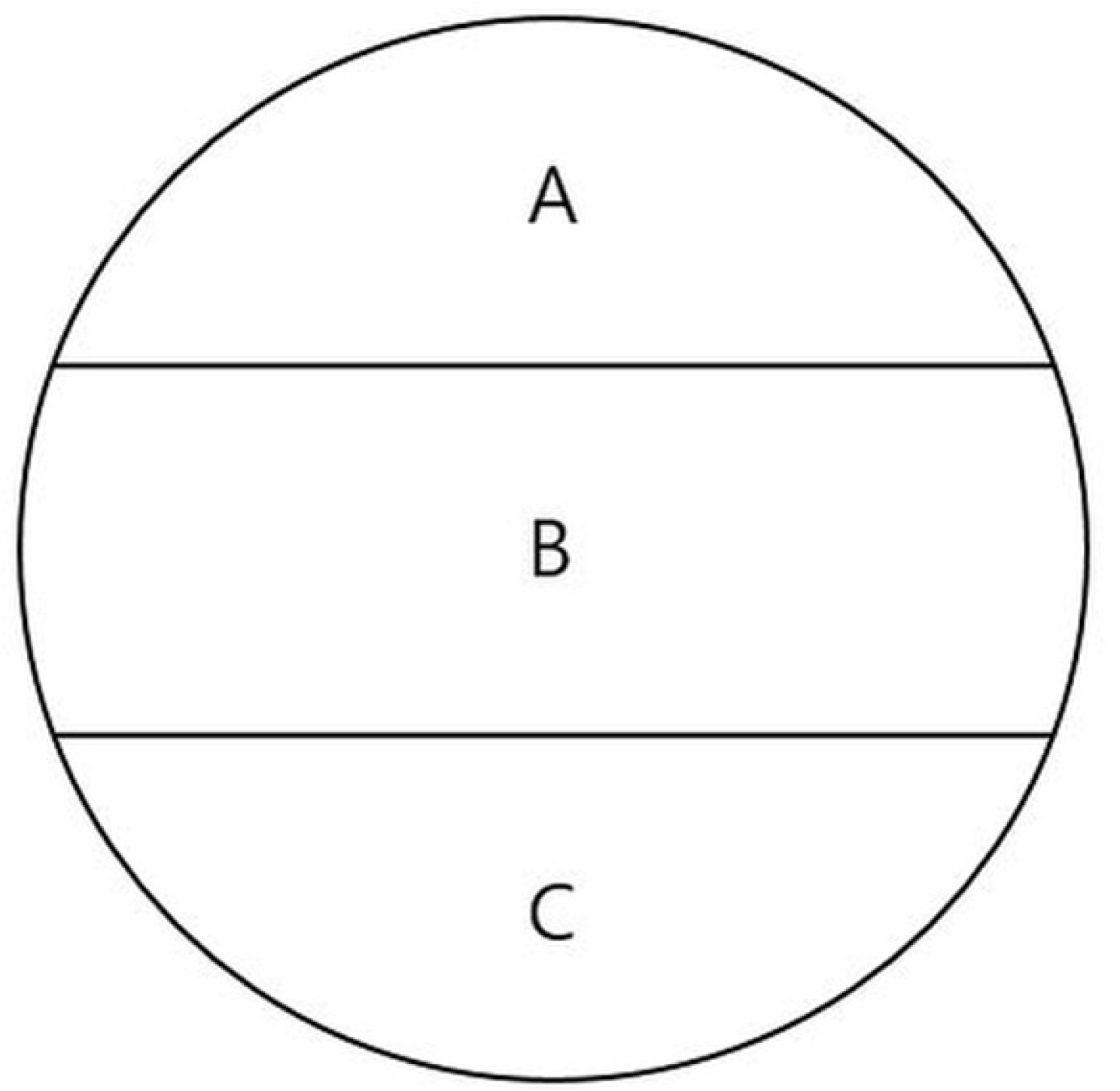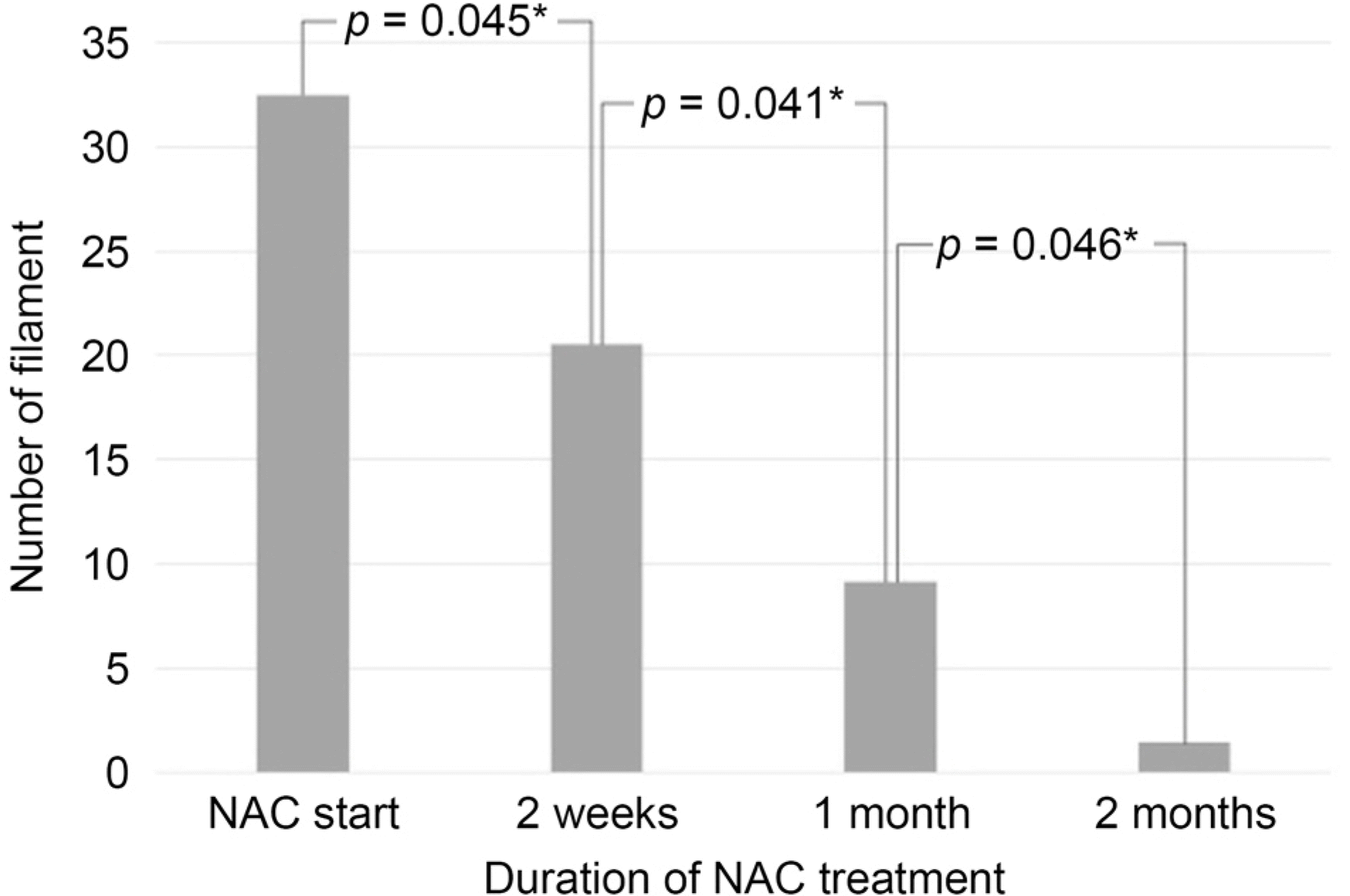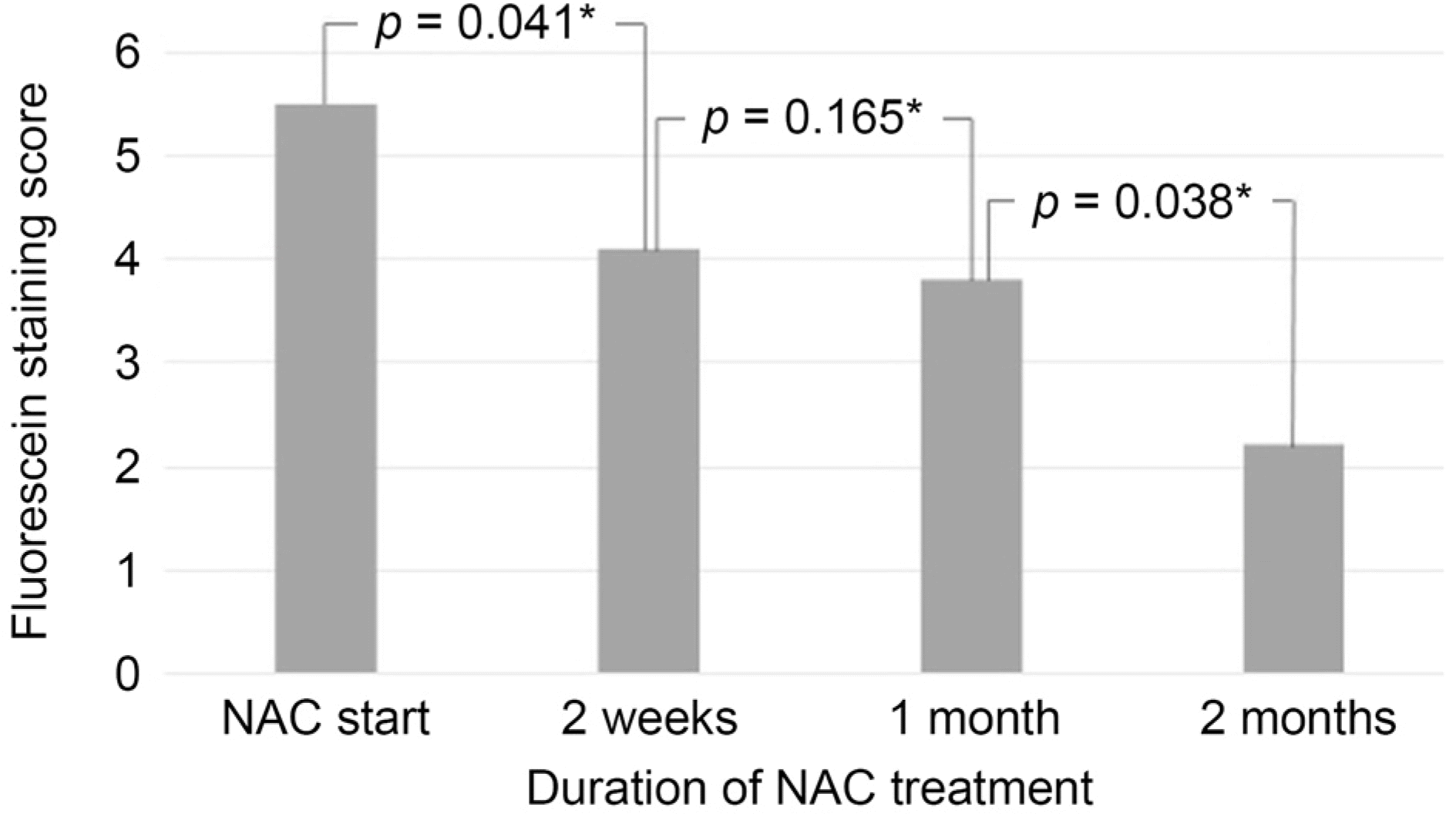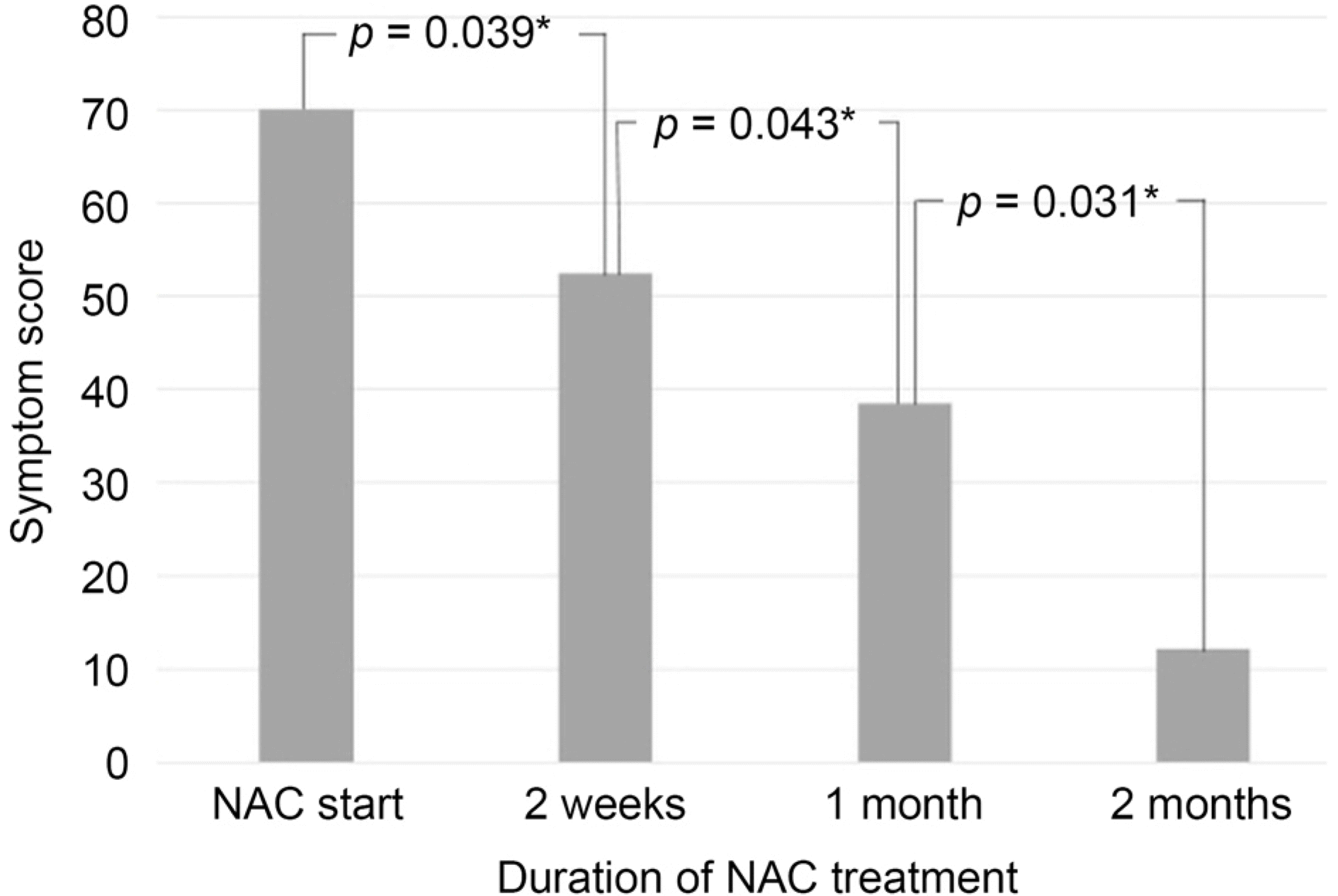Abstract
Purpose
To analyze the effects of topical 10% N-acetylcysteine on patients with refractory filamentary keratitis.
Methods
The present study included 29 eyes from 20 patients diagnosed with filamentary keratitis. We analyzed the cause of filamentary keratitis, types of treatments, symptom scores, number of filaments, fluorescein staining, degrees of remission, and recurrence of the disease.
Results
A total of 19 eyes treated with filament removal, therapeutic contact lenses, topical antibiotics, topical steroids, topical 0.05% cyclosporine, artificial tears, and punctal plugs showed improvements. Topical 10% N-acetylcysteine was added to 10 patients who did not respond to the usual treatment for more than 1 month. Seven eyes showed a complete remission of disease at an average of 56.22 ± 24.52 days. Two eyes showed a partial remission with less than 1–2 fillaments. One eye stopped 10% N-acetylcysteine treatment because of an irritable sensation.
Go to : 
References
1. Zaidman GW, Geeraets R, Paylor RR, Ferry AP. The abdominal of filamentary keratitis. Arch Ophthalmol. 1985; 103:1178–81.
2. Wright P. Filamentary keratitis. Trans Ophthalmol Soc U K. 1975; 95:260–6.
3. Beetham WP. Filamentary keratitis. Trans Am Ophthalmol Soc. 1935; 33:413–35.
4. Theodore FH. Filamentary keratitis. Contact Intraocul Lens Med J. 1982; 8:138–46.
6. Balaram M, Schaumberg DA, Dana MR. Efficacy and tolerability outcomes after punctal occlusion with silicone plugs in dry eye syndrome. Am J Ophthalmol. 2001; 131:30–6.

8. Marsh P, Pflugfelder SC. Topical nonpreserved methylprednisolone therapy for keratoconjunctivitis sicca in Sjögren syndrome. Ophthalmology. 1999; 106:811–6.

9. Grinbaum A, Yassur I, Avni I. The beneficial effect of diclofenac sodium in the treatment of filamentary keratitis. Arch Ophthalmol. 2001; 119:926–7.
10. Bloomfield SE, Jakobiec FA, Theodore FH. Contact lens induced keratopathy: a severe complication extending the spectrum of abdominal in contact lens wearers. Ophthalmology. 1984; 91:290–4.
11. Albietz J, Sanfilippo P, Troutbeck R, Lenton LM. Management of filamentary keratitis associated with aqueous-deficient dry eye. Optom Vis Sci. 2003; 80:420–30.

12. Kojima T, Ishida R, Dogru M, et al. The effect of autologous serum eyedrops in the treatment of severe dry eye disease: a prospective randomized case-control study. Am J Ophthalmol. 2005; 139:242–6.

13. Shimmura S, Ono M, Shinozaki K, et al. Sodium hyaluronate abdominal in the treatment of dry eyes. Br J Ophthalmol. 1995; 79:1007–11.
14. Danjo Y, Watanabe H, Tisdale AS, et al. Alteration of mucin in abdominal conjunctival epithelia in dry eye. Invest Ophthalmol Vis Sci. 1998; 39:2602–9.
15. Albietz JM, Bruce AS. The conjunctival epithelium in dry eye abdominal: effect of preserved and nonpreserved topical treatments. Curr Eye Res. 2001; 22:8–18.
17. Lemp MA, Mathers WD. Corneal epithelial cell movement in humans. Eye (Lond). 1989; 3(Pt 4):438–45.

18. Sheffner AL, Medler EM, Jacobs LW, Sarett HP. The In vitro abdominal in viscosity of human tracheobronchial secretions by acetylcysteine. Am Rev Respor Dis. 1964; 90:721–29.
19. Webb WR. Clinical evaluation of a new mucolytic agent acetylcysteine. J Thorac Cardiovasc Surg. 1962; 44:330–43.

20. Sheffner AL. The reduction in vitro in viscosity of mucoprotein solutions by a new mucolytic agent, N-acetylcysteine. Ann N Y Acad Sci. 1963; 106:298–310.
21. Urashima H, Okamoto T, Takeji Y, et al. Rebamipide increases the amount of mucin-like substances on the conjunctiva and cornea in the N-acetylcysteine-treated in vivo model. Cornea. 2004; 23:613–9.

22. Kamata H, Tanaka C, Yagisawa H, et al. Suppression of nerve growth factor-induced neuronal differentiation of PC12 cells. N-acetylcysteine uncouples the signal transduction from ras to the mitogen-activated protein kinase cascade. J Biol Chem. 1996; 271:33018–25.
23. Oka S, Kamata H, Kamata K, et al. N-acetylcysteine suppresses TNF-induced NF-kappaB activation through inhibition of IkappaB kinases. FEBS Lett. 2000; 472:196–202.
24. Kamata H, Shibukawa Y, Oka SI, Hirata H. Epidermal growth abdominal receptor is modulated by redox through multiple mechanisms. Effects of reductants and H2O2. Eur J Biochem. 2000; 267:1933–44.
25. Absolon MJ, Brown CA. Acetylcysteine in abdominal sicca. Br J Ophthalmol. 1968; 52:310–6.
26. Haut J, Labrune P, Ullern M, Chermet M. New trial treatment of dry eye with acetylcysteine ophthalmic solution. Bull Soc Ophtalmol Fr. 1977; 77:165–7.
27. Thermes F, Molon-Noblot S, Grove J. Effects of acetylcysteine on rabbit conjunctival and corneal surfaces. A scanning electron abdominal study. Invest Ophthalmol Vis Sci. 1991; 32:2958–63.
Go to : 
 | Figure 1.Anterior segment sectioning for fluorescein staining scores. Each compartment was graded on a scale of 0 (no staining) to 3 (intense staining). (A) Superior cornea (B) mid cornea (C) inferior cornea. |
 | Figure 2.Slit-lamp photograph of two patients with refractory filamentary keratitis. (A, B) The left eye of 42-year-old woman with Sjögren's syndrome, 62 filaments were observed in the entire area. After 90 days of 10% N-acetylcysteine treatment, complete remission was observed. (C, D) The left eye of 39-year-old woman with dry eye syndrome, 36 filaments were observed in especially interpalpebral area. After 48 days of 10% N-acetylcysteine treatment, complete remission was observed. |
 | Figure 3.Transition of filament numbers after using topical 10% N-acetylcysteine eyedrop. There were statistically significant decrease of filament numbers in each period. NAC = N-acetylcysteine. * Wilcoxon signed rank test. |
 | Figure 4.Transition of fluorescein staining score after using topical 10% N-acetylcysteine eyedrop. There were statistically significant decrease of fluorescein staining score in each period except between 2 week and 1 month. NAC = N-acetylcysteine. * Wilcoxon signed rank test. |
 | Figure 5.Transition of symptom scores after using topical 10% N-acetylcysteine eyedrop. There were statistically significant decrease of symptom scores in each period. NAC = N-acetylcysteine. * Wilcoxon signed rank test. |
Table 1.
Demographics of the filamentary keratitis patients




 PDF
PDF ePub
ePub Citation
Citation Print
Print


 XML Download
XML Download